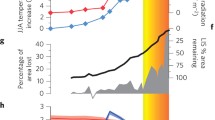Abstract
A global two-dimensional one-level seasonal energy-balance model is asynchronously coupled to vertically integrated ice-flow models (which depend both on latitude and longitude) to study the response of the atmosphere-ocean-cryosphere-lithosphere system to solar forcing for the last ice age cycle of the late Pleistocene. The model simulates the position of the North American and European ice sheet complexes at the last glacial maximum satisfactorily. Both the geographic distributions of the ice volumes delivered by the model and their masses are a reasonable approximation to those inferred on the basis of relative sea level data (Tushingham and Peltier 1990). The sensitivity of the coupled model over the last glacial-interglacial cycle to solar forcing is nevertheless low, which suggests that further physical mechanisms will have to be added to the model (such as explicit basal sliding and ice shelves which would respond to sea-level variations and therefore permit marine incursions), if it is to adequately simulate the terminations that control the 105 year ice age cycle. One should also incorporate long-term variations of the greenhouse gases (Manabe et al. 1985b).
Similar content being viewed by others
References
Andrews JT, Mahaffy MAW (1976) Growth rate of the Laurentide ice sheet and sea level lowering (with emphasis on the 115000 BP sea level low). Quat Res 6:167–183
Berger A (1978) Long-term variations of daily insolation and Quaternary climatic changes. J Atmos Sci 35:2362–2367
Berger A, Gallee H, Fichefet T, Marsiat I, Tricot C (1989) Testing of the astronomical theory with a coupled climate-ice sheet model. In: Labeyrie LD, Jeandel C (eds) Geochemical variability in the oceans, ice and sediments. Global and planetary change. Palaeogeogr Palaeoclimatol Palaeoecol 89 (in press)
Bowman KP (1982) Sensitivity of an annual mean diffusive energy balance model with an ice sheet. J Geophys Res 87:9667–9674
Broccoli AJ, Manabe S (1987) The influence of continental ice, atmospheric CO2 and land albedo on the climate of the last glacial maximum. Clim Dyn 1:87–99
Budd WF, Smith IN (1981) The growth and retreat of ice sheets in response to orbital radiation changes. In: Allison (eds) Sea-level, ice and climatic changes. IAHS 131:369–409
Budd WF, Smith IN (1987) Conditions for growth and retreat of the Laurentide ice sheet. Geogr Phys Quat 41:279–290
CLIMAP project members (1981) Seasonal reconstructions of the Earth's surface at the last glacial maximum. Geol Soc Am Map Chart, Ser, MC-36
Deblonde G, Peltier WR (1990) Simulation of continental ice sheet growth over the last glacial-interglacial cycle: experiments with a one level seasonal energy balance model including realistic geography. J Geophys Res (in press)
Denton GH, Hughes TJ (1983) Milankovitch theory of ice sheet linkage between regional insolation and global climate. Quat Res 20:125–144
Denton GH, Hughes TJ, Karlen W (1986) Global ice-sheet system interlocked by sea-level. Quat Res 26:3–26
Hansen J, Lacis A, Rind D, Russell G, Stone P, Funk I, Ruedy R, Lerner J (1984) Climate sensitivity: analysis of feedback mechanisms. In: Hansen J, Takahashi T (eds) Climate processes and climate sensitivity (AGU monograph 29) American Geophysics Union, Washington D. C., pp 130–163
Hyde WT, Crowley TJ, Kim KY, North GR (1989) A comparison of GCM and energy balance model simulations of seasonal temperature changes over the past 18000 Years. J Climate 2:864–887
Imbrie J, Shackleton NJ, Pisias NG, Morley JJ, Prell WL, Martinson DJ, Hays JD, McIntyre A, Mix AC (1984) The orbital theory of Pleistocene climate: support from a revised chronology of the marine δ18O Record. In: Berger A, Hays J, Kukla G, Saltzam (eds) Milankovitch and climate. Reidel, Dordrecht, pp 269–305
Kutzbach J, Guetter PJ (1986) The influence of changing orbital parameters and surface boundary conditions on climatic simulations for the past 18000 years. J Atmos Sci 43:1726–1759
Kutzbach J, Gallimore RG (1988) Sensitivity of a coupled atmosphere-mixed layer ocean model to changes in orbital forcing at 9000 years BP. J Geophys Res 93:803–821
Mahaffy MW (1974) A three-dimensional numerical method for computing the load distribution of ice sheets with time. M. S. Thesis, University of Colorado, Boulder
Manabe S, Broccoli JA (1985a) The influence of continental ice sheets on the climate of an ice age. J Atmos Sci 42:2643–2651
Manabe S, Bryan K Jr (1985b) CO2 induced change in a coupled ocean-atmosphere model and its paleoclimatic implications. J Geophys Res 90:11689–11707
Marsiat I, Berger A, Fichefet T, Gallee H, Tricot C (1990) Modelling the transient-response of a coupled model to the astronomical forcing over the last glacial cycle. In: Frenzel B (ed) Klimageschichtliche Probleme des Hölozäns und des letzten Interglazials. Palaeoklimaforschung 1, Akademie der Wissenschaft und der Literatur, Mainz. Gustav Fischer, Stutgart New York (in press)
Milankovitch M (1941) Canon of insolation and the ice age problem and glaciation cycles. K Serb Acad Beorg Spec Publ
North GR, Mengel JG, Short DA (1983) Simple energy balance model resolving the seasons and the continents: application to the astronomical theory of the ice ages. J Geophys Res 88:6576–6586
Nye JF (1959) The motion of ice sheets and glaciers. J Glaciol 3:493–507
Oerlemans J (1981) Modelling of Pleistocene ice sheets: some experiments with simple mass balance parameterizations. Quat Res 15:77–85
Pollard D (1980) A simple parameterization for ice sheet ablation rate. Tellus 32:384–388
Pollard D (1983) A coupled climate ice sheet model applied to the Quaternary ice ages. J Geophys Res 88:7705–7718
Rind D (1987) Components of the ice age circulation. J Geophys Res 92:4241–4281
Tushingham M, Peltier WR (1990) ICE-3G: a new global model of late Pleistocene deglaciation based upon geophysical predictions of post-glacial relative sea-level change. J Geophys Res (in press)
Author information
Authors and Affiliations
Rights and permissions
About this article
Cite this article
Deblonde, G., Peltier, W.R. A model of late Pleistocene ice sheet growth with realistic geography and simplified cryodynamics and geodynamics. Climate Dynamics 5, 103–110 (1990). https://doi.org/10.1007/BF00207425
Received:
Accepted:
Issue Date:
DOI: https://doi.org/10.1007/BF00207425




